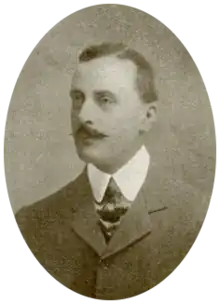John Frederick MacKay VC | |
|---|---|
 | |
| Born | 6 June 1873 Edinburgh, Scotland |
| Died | 9 January 1930 (aged 56) Nice, France |
| Buried | Cimitiere De Caucade, Nice |
| Allegiance | |
| Service/ | |
| Rank | Lieutenant-Colonel |
| Unit | Gordon Highlanders West African Frontier Force Hampshire Regiment Argyll and Sutherland Highlanders |
| Battles/wars | Tirah Campaign Second Boer War World War I |
| Awards | |
Lieutenant-Colonel John Frederick MacKay VC (6 June 1873 – 9 January 1930) was a Scottish recipient of the Victoria Cross, the highest and most prestigious award for gallantry in the face of the enemy that can be awarded to British and Commonwealth forces.
Details

He was 26 years old, and a lance-corporal in the 1st Battalion, The Gordon Highlanders, British Army during the Second Boer War when the following deed took place at Crow's Nest Hill, Johannesburg, for which he was awarded the VC.
On the 29th May, 1900, during the action on Crow's Nest Hill, near Johannesburg, Corporal McKay repeatedly rushed forward, under a withering fire at short ranges, to attend to wounded comrades, dressing their wounds whilst he himself was without shelter, and in one instance carrying a wounded man from the open, under a heavy fire, to the shelter of a boulder.[1]
His Victoria Cross is displayed at the Gordon Highlanders Museum, Aberdeen, Scotland along with his other medals.[2]
| Ribbon | Description | Notes |
| Victoria Cross (VC) |
| |
| India Medal |
| |
| Queen's South Africa Medal |
| |
| King's South Africa Medal |
| |
| Africa General Service Medal |
| |
| 1914–15 Star |
| |
| British War Medal |
| |
| Victory Medal |
| |
Further service
Mackay was commissioned into the King's Own Scottish Borderers as a second lieutenant on 27 July 1901, while still in South Africa. Following the end of the Second Boer War in June 1902, he left Durban for England on the SS Nubia in August 1902.[3] One year later, he was promoted to acting lieutenant while serving with the West African Frontier Force (WAFF). This rank was confirmed in 1905. He transferred to the Hampshire Regiment as a captain in 1907 and to the Argyll and Sutherland Highlanders in 1908, still attached to the WAFF. He served with the Argylls for the rest of his career, although attached to other regiments. From November 1908 to 1912 he served as adjutant of the 7th (Volunteer) Battalion, Royal Scots. In November 1914 he became adjutant of the Indian Volunteers, but later moved to the 21st Battalion, Northumberland Fusiliers (2nd Tyneside Scottish). In 1915 he was promoted major. In August 1916 he was promoted lieutenant-colonel commanding a battalion of the Highland Light Infantry. He retired in 1921.
References
- ↑ "No. 27219". The London Gazette. 10 August 1900. p. 4944.
- ↑ "The Victoria Cross". The Gordon Highlanders Museum. Archived from the original on 14 September 2017. Retrieved 16 September 2017.
- ↑ "The Army in South Africa - Return of Troops". The Times. No. 36844. London. 12 August 1902. p. 10.
- Monuments to Courage (David Harvey, 1999)
- The Register of the Victoria Cross (This England, 1997)
- Scotland's Forgotten Valour (Graham Ross, 1995)
- Victoria Crosses of the Anglo-Boer War (Ian Uys, 2000)